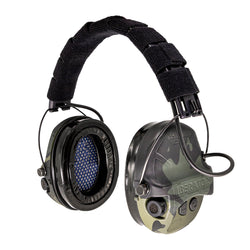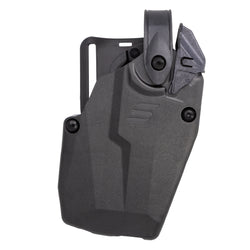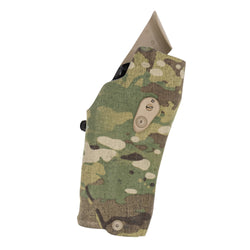Camouflage is one of the oldest tricks in nature’s playbook. Animals on both land and sea have mastered the art of blending in with their environment, hiding from both predators and prey. Their survival depends on it.
The same is true for we humans, and militaries around the world have spent the better part of the last century trying to perfect it.
In the United States, the evolution of military camouflage tells a unique story; one of changing battlefields, shifting tactics, and lessons learned through real-world use in war and conflict.
But there’s more to camouflage than just blending in. It’s a visual battlefield chess match, where geometric patterns and muted colors are carefully crafted to disrupt outlines, break up shapes, and manipulate the way the human eye perceives distance and movement.

Over the decades, the U.S. military has experimented with everything from hand-painted helmets and equipment to high-tech digital patterns, each tailored to the unique demands of different terrain and combat environments.
In this article, we’ll briefly trace the history of American military camouflage, from its improvised origins during World War I to the specialized patterns of the modern battlefield.
But before we do, I suppose I should clarify that I am very much a hobby historian with absolutely zero military experience. Any inaccuracy or omission is strictly accidental.
That said, let’s dig in.
Early Camouflage Experiments
Before camouflage patterns became a standard issue in the U.S. military, concealment was largely improvised. During the 18th and 19th centuries, soldiers wore bright, easily identifiable uniforms. The idea was visibility, unit cohesion, and elegance over stealth. It wasn’t until WWI that the art of visual deception and tactical concealment began to take hold.
Between the advent of air reconnaissance and the development of more modern rangefinding technologies, camouflage became a battlefield necessity.
The Advent of Camoufleur Officers
Specialized units known as “camoufleurs” were tasked with creating decoys, painting artillery, and designing concealment schemes. Entire sections of the front lines, including observation posts and supply depots, were carefully disguised using painted canvas, netting, and natural foliage.
Tanks, field guns, and long-range artillery were painted to blend in with the desolate wastelands of no man’s land. Ships and other naval assets, too, were subject to camouflage efforts, such as the iconic “dazzle camouflage” pattern. Developed by the American and British navies in direct response to German submarine warfare, it featured bold geometric patterns designed to confuse enemy rangefinders and make it difficult to determine a ship’s speed and heading.
A far cry from the battlefields of the 19th century and before, no doubt.
Ironically, though, when it came to standard-issued uniforms, the art of camouflage was exceptionally limited, as the focus on battlefield concealment during World War I was directed toward equipment, artillery positions, and defensive structures rather than the soldiers themselves.

American soldiers still wore standard-issue olive-drab wool uniforms and the iconic “Doughboy” helmet. While some snipers and scouts might have used local foliage, netting, or custom, hand-painted helmet patterns for concealment, official, standardized camouflage uniforms didn’t yet exist.
At the time, it was believed that a simple, muted uniform color, such as olive drab, was sufficient for blending in at a distance, especially in the muddy, cratered landscapes of the Western Front, and personal camouflage was largely left to individual ingenuity and necessity.
Regardless, camouflage had evolved from a theoretical concept to a practical battlefield tool, one that would only grow in importance with each passing conflict.
The Birth of Camouflage Clothing in World War II
It wasn’t until World War II that the U.S. military issued its first true camouflage uniforms for use by American Marines in the Pacific theater.
While soldiers in the European theater still utilized the traditional OD green uniform, the Pacific theater’s dense jungles and the threat of ambush warfare created an obvious need for something that could help American troops disappear into the foliage and better protect their tactical positions.
The M1942 Jungle Camouflage
One of the earliest American camouflage uniforms was the M1942 jungle camouflage, often nicknamed the “frogskin” pattern. Developed by civilian horticulturist Norvell Gillespie, this pattern was highly effective in dense forest and jungle environments. So much so, in fact, that the modern German Flecktarn pattern is a direct descendant.

However, the pattern wasn’t universally popular. Friendly fire incidents, where American troops mistook camouflaged Marines for Japanese soldiers, were cause for concern, with many commanders discontinuing its use and reverting to the standard-issue OD green uniform. Nevertheless, the M1942 was the first real step toward standardizing camouflage uniforms for American forces.
Specialized Camouflage
Despite the failures of the M1942 frogskin uniform, there was, of course, an obvious benefit to battlefield camouflage. As such, WWII snipers and reconnaissance troops began using handmade ghillie suits and locally modified camo gear.
These personalized systems offered better concealment than the limited-issue uniforms, underscoring the need for patterns and clothing tailored to specific roles and battlefield environments.
Helmet scrims, complete with burlap or canvas scraps and native foliage, were widely used as they created highly effective, irregular textures that broke up their silhouette in natural battlefield environments. Some units even painted their helmets or applied mud and charcoal to soften their appearance in the field.
These improvised concealment methods highlighted the inadequacy of one-size-fits-all uniforms in the varied terrains of Europe and the Pacific, where a soldier could move from dense forest to open farmland or urban rubble within a single operation. Though official camo uniforms remained rare, these field-made solutions demonstrated how vital individualized concealment had become for survival and mission success.
The Post-War Years and Korean Conflict
Following World War II, the U.S. military returned to standard olive drab uniforms for most of its forces. The Korean War was fought in varied terrain, from mountainous forests to open plains, but camouflage uniforms were not widely issued.
Instead, the focus remained on fieldcraft, concealment positions, and the occasional use of improvised foliage. Soldiers relied heavily on terrain awareness and natural cover, adapting their positions to the environment rather than depending on specialized uniforms for concealment.
Though some camouflage helmet covers and ponchos were issued, especially in reconnaissance and sniper units, camouflage patterns remained a specialist’s tool rather than a standard-issue item.
These limited pieces were typically reserved for troops operating behind enemy lines or conducting forward observation missions, where the risks of detection were highest. American military leadership still viewed camouflage uniforms as a situational luxury rather than a battlefield requirement, believing that effective concealment came down to training, discipline, and tactical positioning more than clothing.
It wouldn’t be until Vietnam that this philosophy would begin to shift. Albeit slowly.
Vietnam: The Return and Expansion of Camouflage
The Vietnam War marked a turning point for American camouflage. Dense jungles, thick canopies, and elusive guerrilla fighters made concealment critical for survival. The war’s unforgiving environment drove the military to re-evaluate and expand its camouflage options.
The ERDL “Leaf” Pattern
In the late 1960s, the U.S. military introduced the ERDL (Engineer Research and Development Laboratory) pattern. Developed by the Army’s R&D lab in 1948, but not utilized until Vietnam, the ERDL pattern featured a four-color woodland design consisting of greens, browns, blacks, and beige. It was initially produced in a “lowland” variant with dominant greens and a “highland” version with more browns.
Issued primarily to special operations units, reconnaissance troops, and elite forces, such as MACV-SOG and LRRP teams, ERDL uniforms offered significant advantages in Vietnam’s terrain. While it never fully replaced olive drab for regular troops, it paved the way for the broader adoption of camouflage in the U.S. military.
Tigerstripe: The Iconic Unofficial Pattern
If there’s one pattern most closely associated with the Vietnam War, it’s the iconic Tigerstripe pattern. Although never officially adopted by the U.S. military, it was widely worn by Special Forces, advisors, reconnaissance units, and snipers. The Tigerstripe’s jagged, horizontal stripes were uniquely effective in jungle environments, where dense foliage, shifting light, and broken terrain made traditional solid-color uniforms stand out.

The pattern’s disorganized stripes of green, brown, and black blended seamlessly with the tropical undergrowth and thick jungles of the Vietnamese countryside.
Its distinctive look made it a favorite not just for practical reasons, but also as a badge of identity among elite units. Wearing Tigerstripe marked a soldier as part of a tight-knit, highly trained community operating on the fringes of conventional warfare.
It carried a certain mystique, often acquired through unofficial means or local procurement rather than formal supply chains. To this day, the Tigerstripe pattern holds a cult following in military circles and among surplus collectors.
The Cold War and the Rise of Woodland Camouflage
As the Vietnam War ended and the Cold War continued, the U.S. military recognized the need for a standardized camouflage pattern for its conventional forces. This would lead to one of the most recognizable camouflage patterns in American history.

Introduced in 1981, the M81 Woodland pattern was a modified version of the ERDL design, with enlarged blotches and a higher-contrast color palette. It was designed to be effective in temperate woodlands, highlighting NATO’s focus on potential conflict zones in Europe.
The M81 Woodland pattern became the standard camouflage for nearly all branches of the U.S. military throughout the 1980s and 1990s. Soldiers wore it from the forests of Germany to the jungles of Panama, and even in the arid environments of the Gulf War, where its limitations began to show.
Desert Warfare and the Birth of Specialized Patterns
The Gulf War highlighted a key problem with the one-size-fits-all approach. The M81 woodland camouflage was poorly suited to the barren, sand-colored landscapes of the Middle East. In response, the U.S. military developed several new desert-specific patterns.
Six-Color Desert (Chocolate Chip)
The first widely issued desert camouflage was the Six-Color Desert Pattern, nicknamed “Chocolate Chip” for its dark brown, cookie-like blotches. Originally designed in the 1960s, it wasn’t fielded until Desert Storm in 1991.

Though reasonably effective against rocky desert backgrounds, it was less useful in vast, featureless sandscapes. The pattern’s high-contrast design stood out at a distance, prompting the need for a replacement. Further, it was expensive to manufacture.
Three-Color Desert (Coffee Stain)
By the mid-1990s, the U.S. military transitioned to the Three-Color Desert Pattern, also known as “Coffee Stain.” Featuring tan, light brown, and pale green shapes on a sandy background, this pattern was better suited to the Middle Eastern environments that U.S. forces were increasingly operating in.

It would go on to serve through the late 1990s and into the early years of the Global War on Terror, including the initial invasion of Iraq in 2003.
The Digital Camouflage Era
The early 2000s brought about a new wave of military camouflage designs, driven by advances in computer-generated patterns and the belief that pixelated designs could better disrupt human visual perception.
Marine Corps MARPAT
The United States Marine Corps led the charge with the introduction of MARPAT (Marine Pattern) in 2002. Using a pixelated, digital design available in woodland and desert variants, MARPAT was the first U.S. camouflage pattern to incorporate micro-patterning technology.

Notably, MARPAT also introduced the concept of proprietary camouflage, with the Marine Corps limiting its use exclusively to Marines. It was widely regarded as a highly effective camouflage system and set a precedent for other services to follow.
Army Universal Camouflage Pattern (UCP)
The U.S. Army’s attempt at a one-size-fits-all digital pattern was introduced in 2004 with the UCP pattern. Intended to replace both the woodland and desert uniforms with a single camouflage suitable for all environments, UCP used a gray-green pixelated design.

In practice, UCP proved to be a failure. It blended poorly in most natural environments, leaving much to be desired, with many ground troops feeling that their uniforms were more of a liability than an asset.
Despite initial optimism, it was quickly criticized by troops, and by 2015, the Army had started phasing it out in favor of the newer and far more popular OCP pattern.
Return to Environment-Specific Patterns
After the shortcomings of UCP, the U.S. military pivoted back toward developing environment-specific camouflage.
Operational Camouflage Pattern (OCP)
In 2015, the U.S. Army adopted the Operational Camouflage Pattern (OCP), based on the popular Multicam design. OCP features a blended mix of greens, browns, and beiges, effective in a wide range of environments, from temperate forests to arid deserts.
The success of the OCP pattern lies in its ability to adapt to multiple battlefield environments, including urban, woodland, and sandy desert environments. It performs well across different theaters without the drawbacks of the UCP’s overly neutral palette.
Today, OCP is the standard camouflage pattern for U.S. Army soldiers and Air Force personnel, with other branches continuing to use their own specialized patterns.
Where We Stand Today
Modern camouflage is no longer limited to patterns on clothing. It now extends to body armor, helmets, vehicles, aircraft, and even advanced adaptive systems that can change appearance in response to environmental conditions.
The U.S. military’s approach to camouflage continues to evolve, with ongoing research into more modern camouflage that works against night vision, thermal imaging, and other detection systems. As the battlefield becomes increasingly digitized and technology-dependent, the future of camouflage will likely combine traditional visual disruption with electronic and thermal concealment capabilities.
The history of American military camouflage is one of constant adaptation. From the hand-painted patterns of World War I to the digital designs of the 21st century, every new pattern reflects the demands of the battlefield it was designed for. It’s a story shaped by geography, technology, and hard-learned lessons about what it takes to survive in combat.
And as battlefield conditions continue to change and the adversaries continue to advance and evolve, so too will camouflage patterns and technology.









